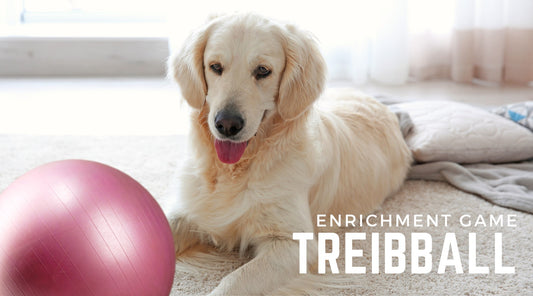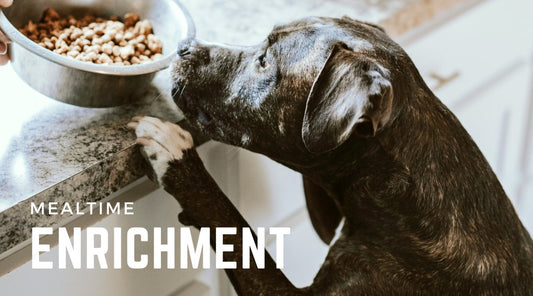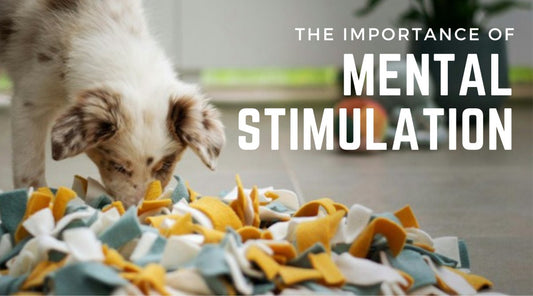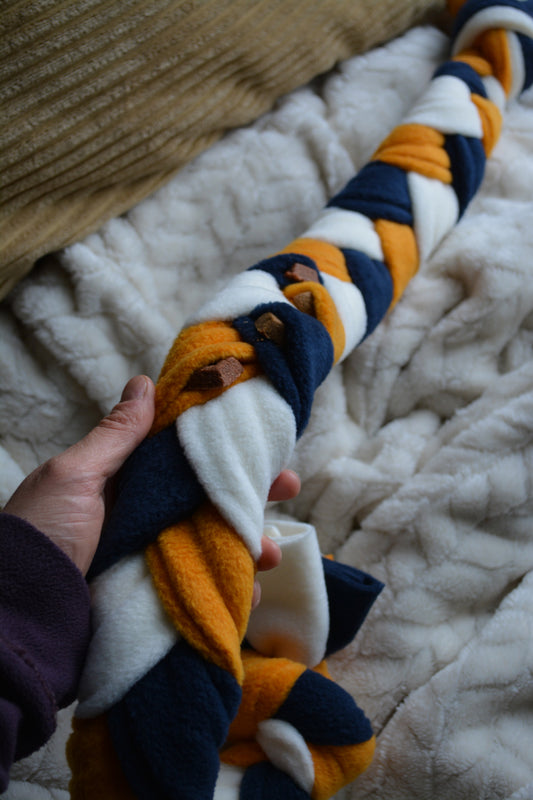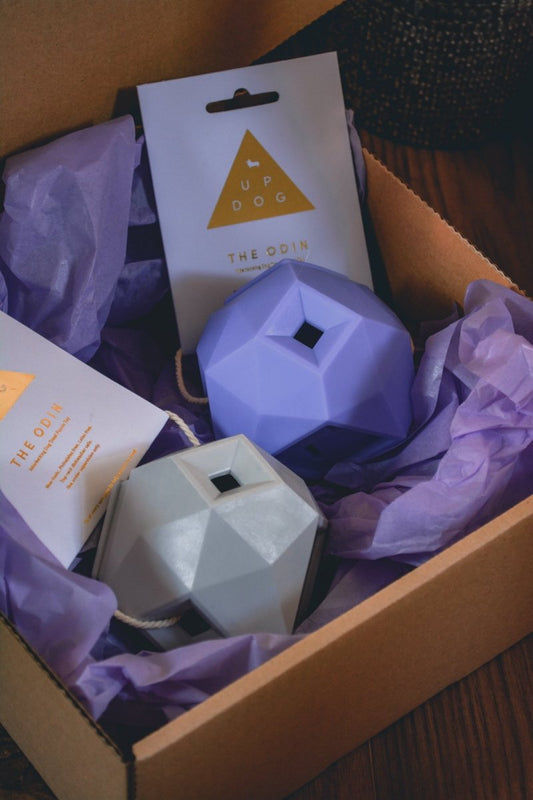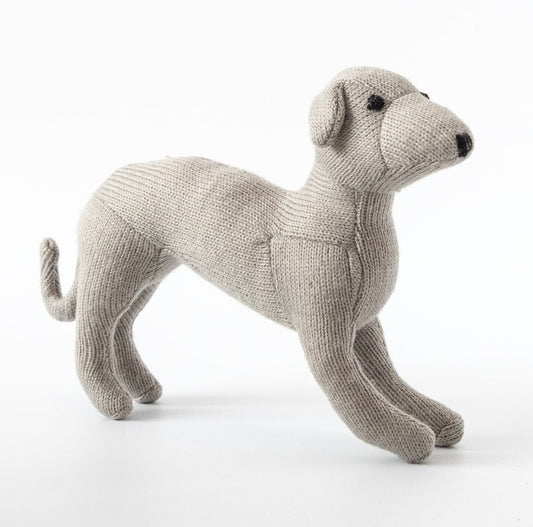Have you ever heard of Treibball?
While I don’t have a herding breed myself, this can be a fun enrichment activity and brain game for any dog.
If you do have herding breed, such as a collie, shepherd, cattle dog, sheep dog or corgi, it's ideal as breed-specific enrichment!

So what is Treibball?
Treibball, translated from German as "drive ball," is a sport that challenges your dog to herd and manoeuvre large exercise balls into a goal area.
Unlike traditional herding sports where dogs work with livestock, Treibball replaces sheep or cattle with large, inflatable balls, offering a safer and more accessible alternative.
What equipment do you need?
As this is a herding activity, you’ll want to use a ball that is large enough for your dog to push, rather than pick it up with their mouth. So if you have a small dog, a football could suffice.
Most people use exercise balls as these are large, lightweight yet durable. You don't want to use a ball that could pop and scare your dog.
You also need to create a ‘goal’ area. This can be marked with a couple of sticks/poles if playing outdoors, or you can use cones indoors.
How to play Treibball
In Treibball, there are multiple balls and the aim of the game is to work with your dog to get each ball into the goal. You stand in the goal area, giving your dog cues which help them herd each ball. Oh, and like other herding sports, it's timed.
While you can take this sport as far as Treibball competitions, for enrichment purposes, we’ll do a simplified version for the living room or garden with one ball and no time limit.
Even still, this requires focus, control and problem solving. It’s great for dogs who thrive on mental stimulation.
1. How to teach the "Touch" cue
To get started, you’ll need to teach your dog to push the ball with their nose using positive reinforcement.
The “touch” cue is a solid foundation for this.
You simply offer an open palm, marking and rewarding every time your dog touches your palm with their nose (closed mouth).
Most confident dogs are curious, so you will be capturing their curiosity as they go to investigate your open palm.
Once they are well accustomed to touching your palm every time you offer it, add in the verbal cue, “touch”.
Remember, you want your dog to come to you - you don't want to impose your hand into their face. It should be entirely non-confrontational and if you don't touch your hand, no bother.
If they are happy with physical contact and are just a bit baffled about what you want, you can put a smidge of food on your palm to encourage them to come forward to sniff it.
Mark and reward any orientation towards your palm. The only action we don't want to mark are open mouth approaches.
For any dogs that are overexcited, calm things down by using less exciting food as the reward and only marking closed mouth touches.
If you dog is nervous of making contact, as some rescue dogs sadly are, then it would be best to support their emotional needs first by working with a behaviourist before trying to introduce games.
2. How to teach the "Push" cue
Next you will need to teach your dog to push.
One way to get the push motion is to teach your dog to close a door. You do this in the same manner as “touch” - replacing your hand with a target, such as a post-it note.
Start by offering out the post it note as you did with your open palm. Once they are touching the target that you are holding out for them, you can then start to place it down and cue "touch".
Now they will be touching the target independently from you. You can then place the target on a closed door and cue "touch".
Make sure the post it note is at comfortable nose height for your dog.
Next, gradually shape the pressure and duration of that touch into a push. Do this by opening the door slightly and cueing "touch".
You'll want to make sure you use a door that closes easily without much contact - such as a lightweight cupboard door. Ultimately, you will mark and reward once the door closes.
Once your own is reliably pushing the door closed, you can then introduce “push” as a cue.
3. Create an easy Push Ball course
Next, setup an easy course for your dog.
All Dogs Are Smart has a simple video for this. Essentially, you capture the push by laying two poles down on the ground, parallel to each other (think of a runway).

Place the ball at one end and line the runway with treats. This encourages your dog’s nose down to the ground. They will need to push the ball across the treats.
You’ll likely want to have your dog on the lead so that you can guide them along the runway. Otherwise they may problem solve by going around the ball!
You will mark each time they push the ball to get the treats. Once they are well accustomed to doing this, you will gradually lessen the treats so they have a little further to push each time.
If you have already introduced “push” to close the door, you can use this cue at the start of the runway. Otherwise, introduce “push” here.
When your dog is happy pushing the ball all the way to the end of the poles, you can move onto the next step.
4. It's a goal!
Create a goal area at the end of the runway with upright poles or cones. Now you will be cueing your dog to “push” the ball along the runaway, marking and rewarding once your dog reaches the goal.

You can also gradually increase the distance between you and your dog. As with Treibball, you will end up standing in the goal as your dog herds the ball to you.
All of this alone can be enough of a brain game. However, you can progress to directional cues such as “right” and “left”, along with “wait” to have your dog pause.
Remember, with all of this, go slow, don’t rush, keep it short and engaging with lots of encouragement.
If your dog is getting frustrated, it’s likely you are expecting too much too soon and you need to drop back a few steps and simplify.
This whole process could take weeks if not months.
…But it all serves as mental stimulation and relationship building time with you.
So while Treibball is a sport, it doesn’t need to be competitive.
There are various of Treibball resources available online if you want in-depth guidance. For us, it’s just serves as a fun enrichment game.
Happy playing!


